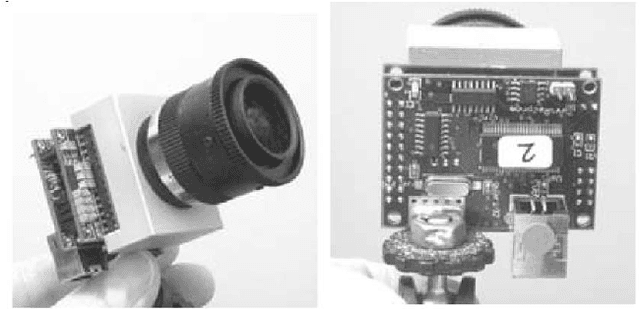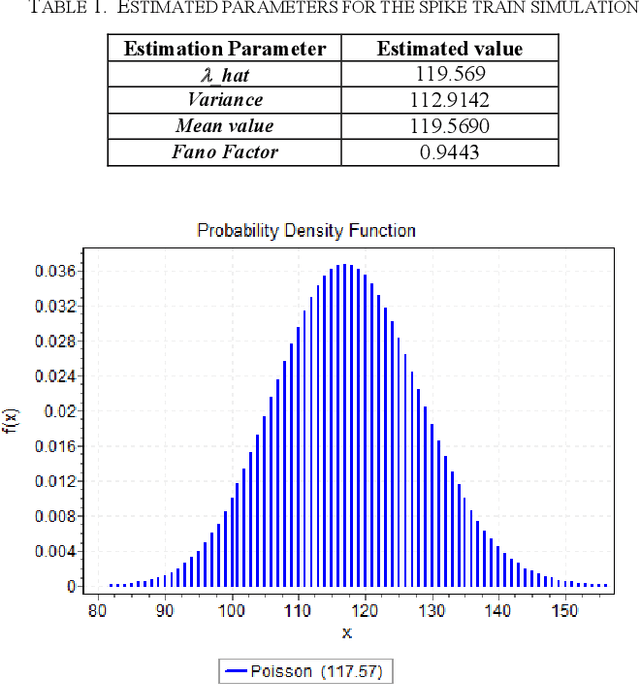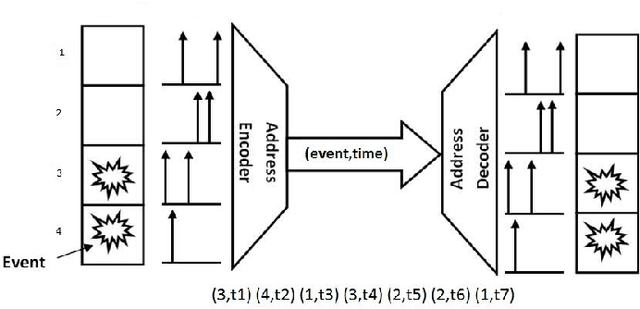Mahyar Shahsavari
GazeSCRNN: Event-based Near-eye Gaze Tracking using a Spiking Neural Network
Mar 20, 2025Abstract:This work introduces GazeSCRNN, a novel spiking convolutional recurrent neural network designed for event-based near-eye gaze tracking. Leveraging the high temporal resolution, energy efficiency, and compatibility of Dynamic Vision Sensor (DVS) cameras with event-based systems, GazeSCRNN uses a spiking neural network (SNN) to address the limitations of traditional gaze-tracking systems in capturing dynamic movements. The proposed model processes event streams from DVS cameras using Adaptive Leaky-Integrate-and-Fire (ALIF) neurons and a hybrid architecture optimized for spatio-temporal data. Extensive evaluations on the EV-Eye dataset demonstrate the model's accuracy in predicting gaze vectors. In addition, we conducted ablation studies to reveal the importance of the ALIF neurons, dynamic event framing, and training techniques, such as Forward-Propagation-Through-Time, in enhancing overall system performance. The most accurate model achieved a Mean Angle Error (MAE) of 6.034{\deg} and a Mean Pupil Error (MPE) of 2.094 mm. Consequently, this work is pioneering in demonstrating the feasibility of using SNNs for event-based gaze tracking, while shedding light on critical challenges and opportunities for further improvement.
Energy-Efficient Spiking Recurrent Neural Network for Gesture Recognition on Embedded GPUs
Aug 23, 2024Abstract:Implementing AI algorithms on event-based embedded devices enables real-time processing of data, minimizes latency, and enhances power efficiency in edge computing. This research explores the deployment of a spiking recurrent neural network (SRNN) with liquid time constant neurons for gesture recognition. We focus on the energy efficiency and computational efficacy of NVIDIA Jetson Nano embedded GPU platforms. The embedded GPU showcases a 14-fold increase in power efficiency relative to a conventional GPU, making a compelling argument for its use in energy-constrained applications. The study's empirical findings also highlight that batch processing significantly boosts frame rates across various batch sizes while maintaining accuracy levels well above the baseline. These insights validate the SRNN with liquid time constant neurons as a robust model for interpreting temporal-spatial data in gesture recognition, striking a critical balance between processing speed and power frugality.
Overcoming the Limitations of Layer Synchronization in Spiking Neural Networks
Aug 09, 2024Abstract:Currently, neural-network processing in machine learning applications relies on layer synchronization, whereby neurons in a layer aggregate incoming currents from all neurons in the preceding layer, before evaluating their activation function. This is practiced even in artificial Spiking Neural Networks (SNNs), which are touted as consistent with neurobiology, in spite of processing in the brain being, in fact asynchronous. A truly asynchronous system however would allow all neurons to evaluate concurrently their threshold and emit spikes upon receiving any presynaptic current. Omitting layer synchronization is potentially beneficial, for latency and energy efficiency, but asynchronous execution of models previously trained with layer synchronization may entail a mismatch in network dynamics and performance. We present a study that documents and quantifies this problem in three datasets on our simulation environment that implements network asynchrony, and we show that models trained with layer synchronization either perform sub-optimally in absence of the synchronization, or they will fail to benefit from any energy and latency reduction, when such a mechanism is in place. We then "make ends meet" and address the problem with unlayered backprop, a novel backpropagation-based training method, for learning models suitable for asynchronous processing. We train with it models that use different neuron execution scheduling strategies, and we show that although their neurons are more reactive, these models consistently exhibit lower overall spike density (up to 50%), reach a correct decision faster (up to 2x) without integrating all spikes, and achieve superior accuracy (up to 10% higher). Our findings suggest that asynchronous event-based (neuromorphic) AI computing is indeed more efficient, but we need to seriously rethink how we train our SNN models, to benefit from it.
STAL: Spike Threshold Adaptive Learning Encoder for Classification of Pain-Related Biosignal Data
Jul 11, 2024Abstract:This paper presents the first application of spiking neural networks (SNNs) for the classification of chronic lower back pain (CLBP) using the EmoPain dataset. Our work has two main contributions. We introduce Spike Threshold Adaptive Learning (STAL), a trainable encoder that effectively converts continuous biosignals into spike trains. Additionally, we propose an ensemble of Spiking Recurrent Neural Network (SRNN) classifiers for the multi-stream processing of sEMG and IMU data. To tackle the challenges of small sample size and class imbalance, we implement minority over-sampling with weighted sample replacement during batch creation. Our method achieves outstanding performance with an accuracy of 80.43%, AUC of 67.90%, F1 score of 52.60%, and Matthews Correlation Coefficient (MCC) of 0.437, surpassing traditional rate-based and latency-based encoding methods. The STAL encoder shows superior performance in preserving temporal dynamics and adapting to signal characteristics. Importantly, our approach (STAL-SRNN) outperforms the best deep learning method in terms of MCC, indicating better balanced class prediction. This research contributes to the development of neuromorphic computing for biosignal analysis. It holds promise for energy-efficient, wearable solutions in chronic pain management.
evt_MNIST: A spike based version of traditional MNIST
Apr 22, 2016



Abstract:Benchmarks and datasets have important role in evaluation of machine learning algorithms and neural network implementations. Traditional dataset for images such as MNIST is applied to evaluate efficiency of different training algorithms in neural networks. This demand is different in Spiking Neural Networks (SNN) as they require spiking inputs. It is widely believed, in the biological cortex the timing of spikes is irregular. Poisson distributions provide adequate descriptions of the irregularity in generating appropriate spikes. Here, we introduce a spike-based version of MNSIT (handwritten digits dataset),using Poisson distribution and show the Poissonian property of the generated streams. We introduce a new version of evt_MNIST which can be used for neural network evaluation.
 Add to Chrome
Add to Chrome Add to Firefox
Add to Firefox Add to Edge
Add to Edge